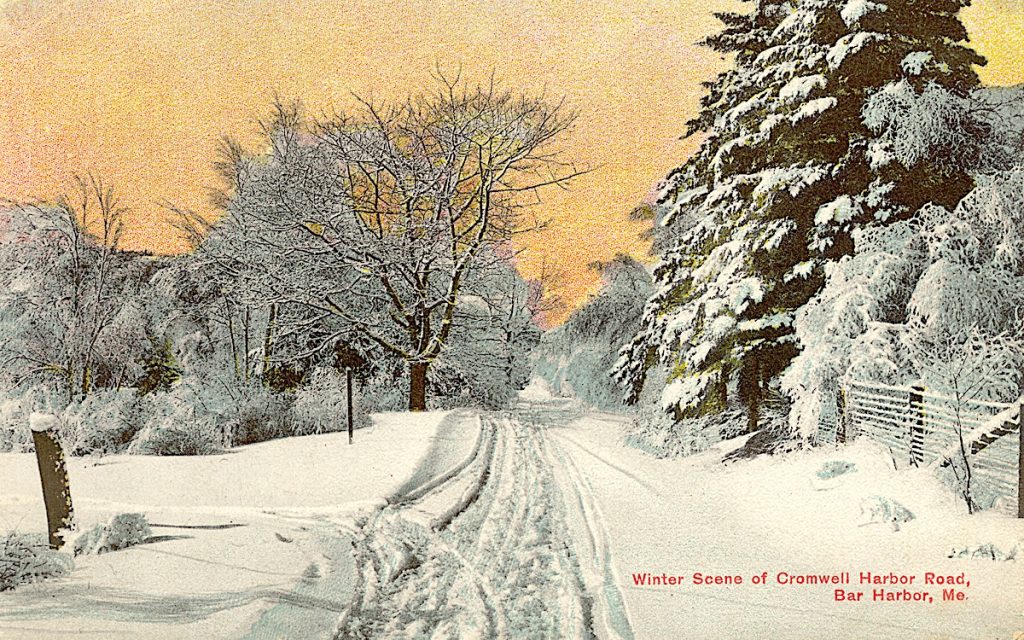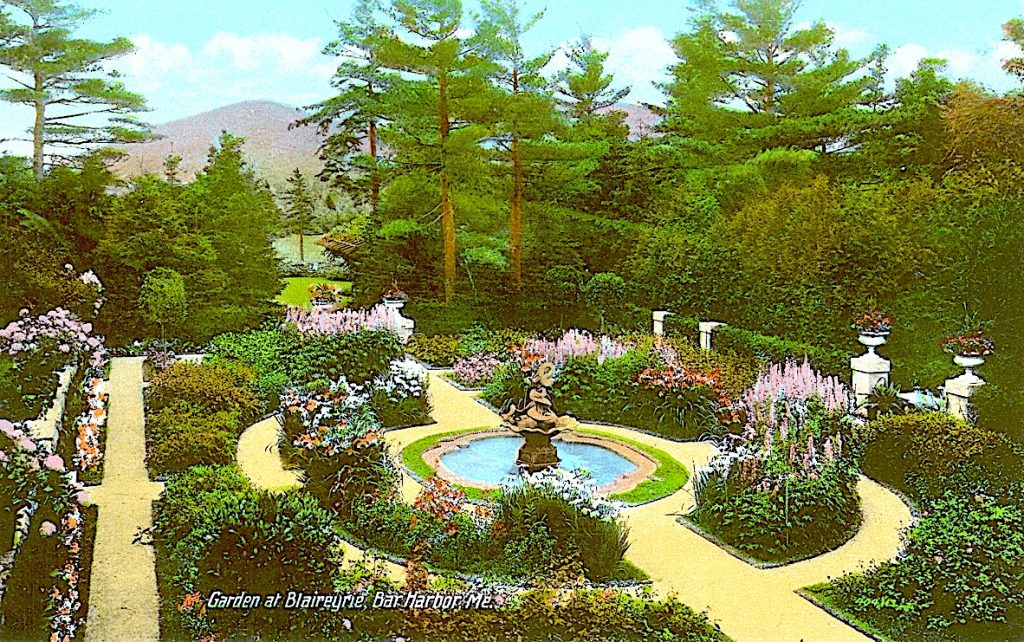Yes, Bar Harbor is a college town! It hosts a campus of a most unique college ever. The college is really small, with only 350 students. It is an environmental college where students learn in the field, thanks to the next door Acadia National Park and the Atlantic Ocean. But most importantly, their grounds are open to the Mount Desert Island community. Here, you can touch alive sea-star, find a whale skull, walk through many different gardens, and marvel at another Bar Harbor historical mansion, one of the few survivals of The Great Fire. The best part is that the campus is only 5 minutes bus ride on the Island Explorer Route 2 from Bar Harbor (no parking on campus).

Well, let’s tour the grounds!
- After you enter the grounds through the main entrance, continue until you spot an old whale skull. It is set against the wall of the Arts and Sciences Building.
- On your left is the Museum of Natural History. It is housed in the first original headquarters of Acadia National Park. This building was built in Bar Harbor and, in 1990s, relocated here and enlarged.
- Can you tell what part of the building is of the original construction?
- What person was the museum named after?
- What natural landmark in Acadia National Park was named after the same person?
- Tide-pooling or Where the Tide is Always Perfect.
Tides govern coastal life and are created by the gravitational pull of the moon. The average change in water level between high and low tide in the Mount Desert Island area is 10-11 feet. Every six hours or so the tide begins either ebbing or flowing- fortunately, this gives you lots of time to observe the phenomena. Waters of the Atlantic Ocean surrounding Mount Desert Island contain an unknown number of invertebrate species. As the tide recedes, pockets in the rocky shore trap pools of water along with a number of fascinating creatures. It makes tide-pooling is a fun adventure to do during low tide. But what if the tide is not on your side during your stay on Mount Desert Island, or you have small kids who want a closer look and a touchy experience?

The Museum of Natural History offers a fun hands-on exhibit, Touch Tank, that features live coastal sea creatures, such as sea stars, crabs, snails and more, from Frenchman Bay. In fact, all its dioramas are made by the students. The museum operates on donations. Check for opening hours before visiting.
- The Heart of the Campus
After visiting the museum, continue on a gravel path behind the Arts and Sciences Building. There, in the small courtyard, spot a stone feather monument, by Gary H. Smith. Take its picture, as you won’t find it on the Internet.
Continue walking towards Kaelber Hall until you see the pink and grey flagstones that frame Newlin Garden, designed and constructed with the help of students in 1991.
Now you are standing before rebuilt Kaelber Hall, the heart of the campus. The first Kaebler Hall, more than a century old cottage called Guy‟s Cliff, burned in 1983 fire, together 17,000-volume library. Today, Thorndike Library take the whole second floor of Kaelber Hall. It serves the college and open to the Mount Desert Island community. Walk under the distinctive archway underneath the library onto the other side.

The seaward hillside of Kaelber Hall built into a terrace garden. Much famed landscape architect Beatrix Farrand designed it herself (including stone walls) for the original cottage in 1928. Throughout the cottage era, many Mount Desert Island summer residents built and maintained elaborate and beautiful gardens of imported European plants. Interestingly, now nearly 200 plant species found on the island are non-native. Unfortunately, the Great Fire of 1947 destroyed many of the gardens, including Farrand’s. But, the garden on campus survived. Take time to explore both terraces. How many levels does they have?
- Chaos is the Law of Nature or How Tending Orderly Gardens is the Endless Challenge
Now, turn left and continue until you see a tucked away French Chateau historical mansion, a small castle, really.

Source: Wilfredor, CC0, via Wikimedia Commons
John Emery built his Bar Harbor summer residence, a fortress-like mansion known as The Turrets, in 1895. The Turrets was designed by Bruce Price, the same architect who designed the Le Chateau Frontenac hotel in Quebec, Canada. The stone for the building was quarried from a quarry near Eagle Lake. The mansion represents one of the finest examples of French Chateau style.
The cottage survived the Great Fire of 1947 but was abandoned 6 years later, after the death of John’s wife, Mrs. Lela Emery Anson, at the age of 88. Since than it fell into disrepair many times. Currently it serves as both campus academic and administrative building for the College of the Atlantic. Enjoy exploring the building’s details as well as the groomed grounds around it. How many chimneys can you spot?
Besides owning one of the grandest of the Bar Harbor mansions, Emery family had two extraordinary gardens, hosting dinners, dances and teas for a decade. First, look for Sunken Garden, located on a lot adjacent to The Turrets. The Moorings cottage formerly occupied the site, but in 1807, John bought it, raised the house and built it into a garden. Can you find it? What shape is it in?
To find The Turrets Seaside Garden, return back to The Turrets and continue walking farther behind The Turrets and toward the sea. During cottage days, it had paths covered by crushed rocks from the island’s quarries, fancy flowers and shrubs, and the boy-and-serpent statue in the fountain. After abandonment, both gardens succumbed to overgrowth and almost disappeared. Today, students take care of the planting and weeding.
Acadia National Park has a path named after John Emery. During his summer stays in Bar Harbor, John was an active member of Bar Harbor Path committee. Committee members worked together to install signs, to map, label, maintain, and repair existing hiking paths on the island, and to build new ones. Unfortunately, in the summer of 1908, at the age of 70, John caught pneumonia and soon died in The Turrets. After John’s death, his former wife, Mrs. Lela Emery Anson, funded the creation of the Emery Path in his memory.
- Back to the Beginning
Locate the Nature Trail that follow the shore. Take it in the direction away from Bar Harbor (left, if you are facing the shore). Walk along till you see the Pier. Continue some more on the Nature Trail and then turn left on the gravel path toward the Arts and Ceramic Studios. There, look for concrete Pillars with unique sets of curves, made by the students in 1992. How many can you count?
Across the poles is the last garden, Community Garden. It is just like the Nature Museum and Thorndike Library, opened to the Mount Desert Island community.
Did you like my quest? Do you want to know more about fun and meaningful quests while visiting Acadia National Park? Then, check out my book available on Amazon as paperback and Kindle editions. Buy a book, change a life!

Copyright © 2022 by E.Gra. Unless otherwise noted, all rights reserved. Unless otherwise indicated, no part of this work may be reproduced, or transmitted in any form or by any means without the author’s prior written consent.
